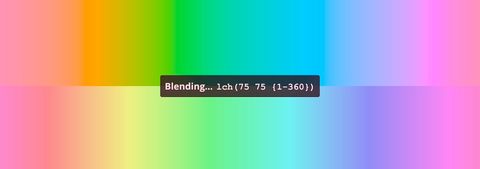
Blend
We’ve been helping to design and implement wide-gamut color support directly in the Sass language.
npm install @oddbird/blendBlend is written using the Sass module syntax, only supported by the Dart Sass compiler at this point.
@use '<path-to>/@oddbird/blend';Lab & LCH Formats
Copy permalink to “Lab & LCH Formats”(CIE) LCH & Lab color-conversion into (sRGB) sass colors:
$cie-to-sass: (
blend.lch(30% 50 300),
blend.lab(60% -60 60),
blend.lch(60% 75 120, 50%), // as %
blend.lab(60% -60 60, 0.5), // or as fraction
);Color Contrast
Copy permalink to “Color Contrast”Based on the proposed Level 5 color-contrast() function:
$contrast: (
// default black or white for best contrast
blend.contrast($color),
// highest contrast
blend.contrast($color, maroon, rebeccapurple, cyan),
// first color with contrast >= 4.5
blend.contrast($color, maroon, rebeccapurple, 4.5),
);Inspecting Colors
Copy permalink to “Inspecting Colors”Inspect LCH & Lab values of Sass colors:
$inspect: (
blend.lightness($color),
blend.a($color),
blend.b($color),
blend.chroma($color),
blend.hue($color),
);Relative Colors
Copy permalink to “Relative Colors”Relative Sass color adjustments using LCH & Lab channels
$adjust: (
// set chroma to 10
blend.set($color, $chroma: 10),
// adjust hue by -10
blend.adjust($color, $hue: -10),
// scale lightness 10% lighter
blend.scale($color, $lightness: 10%),
);A relative-color shorthand, based on rough interpretation of the Level 5 relative color syntax:
$from: (
// set chroma to 20
blend.from($color, l, 20, h),
// linear adjustments to a channel
blend.from($color, l, c, h -60),
// relative scale, e.g. "half-way to white"
blend.from($color, l 50%, c, h),
// multiply the channel value
blend.from($color, 2l, c, h),
);LCH Color Picker
Copy permalink to “LCH Color Picker”To get started with new CSS color formats (and LCH in particular), check out the wonderful LCH Color Picker by Lea Verou.
We use the same conversion math, originally written in JS by Chris Lilley and Tab Atkins.
Color Spaces
Copy permalink to “Color Spaces”A color space provides a way of organizing and describing a particular range (or gamut) of colors. Print design often relies on the CMYK space, while web design has historically been limited to sRGB.
If you write much CSS, you are likely familiar with several sRGB
formats – including hexidecimal, rgb(), and hsl(). While hex and
rgb formats describe the space based on linear adjustments of red,
green, and blue axis, the hsl() format moves around sRGB space as
a cylinder.
But sRGB provides a limited gamut of colors, and some unpredictable
results. While hsl helps provide a human readable format, the colors
are not perceptually uniform – yellow and blue hues with the same
lightness provide drastically different luminosity and contrast.
Some of the new CSS color spaces address the gamut issue, providing
access to a wider range of colors. For example, the wider-gamut
display p3 is a better match for most modern screens (though only
currently supported in Safari).
LCH provides both a wider gamut (theoretically all visible color), along with perceptually uniform distribution. Two colors at the same lightness should provide the same luminosity. That makes LCH a great choice for color systems that involve automation.
Eventually, we will be able to use LCH and other wide-gamut formats directly in the browser, but for now colors must be converted to sRGB – and colors that fall outside the sRGB gamut need to be adjusted.
That’s where we come in.
Open Source Sponsors
Current Sponsors
A huge thank you to the individuals and organizations sponsoring OddBird’s open source work!
Blue-Footed Boobies
Common Loons
Sponsor OddBird’s OSS Work
We love contributing back to the languages & tools that developers rely on, from CSS & Sass to browser polyfills and Python. Help us keep that work sustainable and focused on developer needs!





